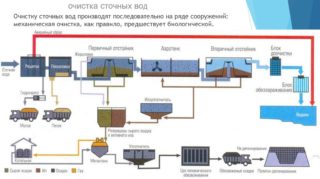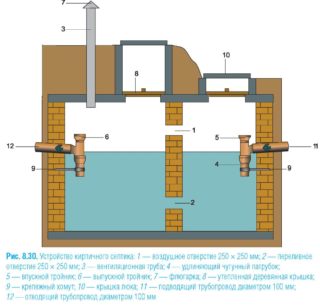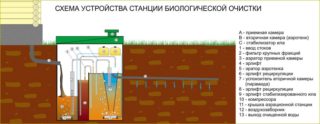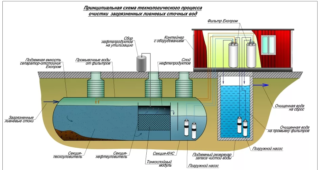Wastewater treatment plants are designed for different degrees of pollution, therefore, the design features of each of them depend on what substances will have to work with and how difficult it is to remove them from the liquid so that it meets all sanitary standards.
Purpose and principle of operation
Industrial effluents are characterized by the presence of chemicals that can cause massive poisoning and even lead to the death of people, animals, fish in the reservoir. For the purification of chemical effluents, reagents are used that neutralize and render harmless the liquid. The effluents of chemical plants may contain acids, alkalis, radioactive elements, and mechanical particles. The treatment plant must take into account the composition of the waste water and apply those methods that are appropriate for the nature of the pollution.
Surface runoff treatment facilities are designed to remove mechanical particles from rainwater, as well as oil products, gasoline, diesel fuel, and various oils. Before entering the sewer system, rainwater washes away the remnants of these substances from highways and car parks, where they get from faulty engines, gas tanks, oil tanks.
The complex of treatment facilities for domestic wastewater should include several stages of liquid removal from organic residues and solid particles. In the decomposition of organic matter, beneficial microorganisms are involved - aerobic and anaerobic - this is the most effective way, which gives almost one hundred percent result. In addition to bacteria, biological treatment plants use mechanical devices - sand traps, fat traps, filters and devices for the final disinfection of pure water - ultraviolet irradiation or chlorination.
After carrying out all the activities, the liquid is checked by a laboratory method for the presence of toxins, pathogens and suspended particles. If the parameters correspond to the norm, the water is sent for reuse to the city water supply network or discharged into natural reservoirs.
Types and structure of treatment facilities
There are sewage treatment plants that receive wastewater from the entire village or district. These are larger structures with a full range of equipment. It is much cheaper to organize such a station by joint efforts.
Industrial effluents are sent to separate storage facilities, where hazardous substances and compounds are removed from them. Usually, they try not to mix chemical waste with household waste, since they require completely different technologies and reagents.
Storm water is considered the cleanest of all, but many foreign objects get into the sewer that need to be separated and disposed of - plastic bottles, paper, plastic bags, large stones and sand.
By structure, surface and underground treatment facilities are distinguished. Surface stations occupy large areas, so they are located outside the city or village. It is more convenient to maintain such facilities, since all units are within the reach of the station's maintenance personnel. The downside is the presence of an unpleasant odor, but for this there are special technologies that allow you to avoid it.
On private territories, it is more profitable to use underground septic tanks so as not to occupy a useful area and not to spoil the appearance of the site with plastic containers. In cottage settlements, both ground and underground biological treatment plants are used, since the wastewater is mainly domestic or surface.
Biological treatment plant design
The system consists of four stages, each of which is important:
- Before the flow of wastewater, preliminary cleaning of garbage is carried out. This requires lattices that trap plastic, cardboard, clothing. All this is collected and disposed of at the city dump.
- Getting into the first tank, the liquid settles, large particles settle to the bottom. Here, organic matter is processed by bacteria, or activated sludge. For the reproduction of microorganisms, a large amount of oxygen is required, therefore, it is additionally supplied from below.
- After the primary sedimentation tank, the purified liquid is sent for additional treatment to the secondary tank. There colonies of bacteria settle to the bottom, from where they are disposed of with special scrapers, which periodically pass along the bottom of the sump.
- Next, an almost pure liquid is irradiated with ultraviolet light or chlorinated in a separate container and sent back to the water intake system.
The technological scheme of treatment facilities for domestic wastewater is the most environmentally friendly of all, since it does not require the use of chemicals. The disadvantages of the system include dependence on electricity, as well as a long process of processing organic matter by microorganisms.
Closed-type surface drainage facilities
There are special filters that capture large oil molecules, remove manganese and iron ions. The most famous substance is activated carbon. There are more modern methods, which are expensive and not yet available for most treatment facilities.
Surface runoff stations are part of urban wastewater treatment plants that work faster, since the chemical treatment method removes contaminants in a short time - less than a day. Such treatment plants are used at gas stations, car washes, oil refineries.
Design of treatment systems
Storm sewage can be combined with household sewage, especially in private autonomous systems. But experts do not recommend doing this, since with a large amount of precipitation, the septic tank can be filled very quickly and sewage spills onto the site.
A more expensive but practical option is to use separate pipes and containers for rain and melt water. In the event of an overflow, nothing bad will happen, but an additional channel can be provided through which water can go outside the site.
It is better to solve all design issues with specialists. They will help you correctly calculate the volume of the septic tank and the diameter of the pipes, as well as make a preliminary marking of the sewage system on the site.Typically, the storm drain is laid next to or under the sewer pipe.
Installation of installations

The installation of sewage treatment plants for storm water in terms of the scope of work is similar to that of a domestic sewage system, so it is better to install these two septic tanks at the same time - at the stage of laying the foundation.
The slope of the pipes is taken into account, as when laying the sewer main. Plastic products are additionally insulated and sprinkled with sand so that the joints do not deform during operation. In places of turns or changes in the level of the pipe, an inspection well is installed for the convenience of removing blockages and checking the condition of the inner walls.
When installing plastic pipes, they rarely have to be cleaned, provided that the installation was carried out in accordance with all the rules.
Due to the large amount of dirt and debris - leaves, branches, stones - for storm drains, it is advisable to install sand traps and grates with large holes that will not allow debris to enter the pipes and form a plug.
Maintenance of treatment facilities
Maintenance of biological treatment plants consists in the timely pumping of spent activated sludge and organic sludge. Periodically, it is necessary to rinse the walls of septic tanks with a powerful jet of water.
Preventive measures at city stations are carried out by personnel; at home, you can do it yourself or conclude an agreement with the company that installed the system. Unfortunately, the maintenance of such facilities is not cheap. In the city sewerage it is carried out at the expense of the city, autonomous - at the expense of the owners. If a full-fledged treatment plant operates on the site, it requires counting the amount of sludge, its growth and removal. If you incorrectly calculate the required amount of bacteria for the current volume of wastewater, the treatment will not be of high quality and organic matter can get back into the water supply system, which is dangerous for the health of the residents of the house.












